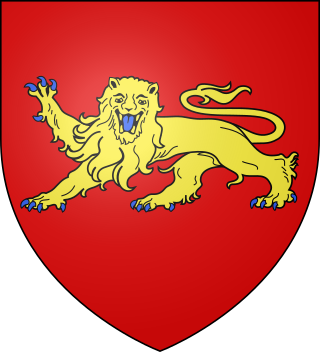Related Research Articles

The House of Montmorency was one of the oldest and most distinguished noble families in France.

The House of La Trémoïlle(Maison de La Trémoille in French) was a French noble family from Poitou whose name comes from the village La Trimouille in the department of Vienne. This family has been known since the middle of the 11th century, and since the 14th century its members have been conspicuous in French history as nobles, military leaders and crusaders, and influential as political leaders, diplomats, Huguenots and courtiers. The male line of the family died out in 1933, while female line heirs of the last duke have kept the La Trémoïlle surname alive in Belgium.

Gilles de Rais, Baron de Rais, was a knight and lord from Brittany, Anjou and Poitou, a leader in the French army, and a companion-in-arms of Joan of Arc. He is best known for his reputation and later conviction as a confessed serial killer of children.

The Diocese of Laval is a Latin Church ecclesiastical territory or diocese of the Catholic Church in France. The episcopal see is Laval Cathedral in the city of Laval. Created in June 1855, the diocese was originally erected from the Diocese of Le Mans, and corresponds to the department of Mayenne. Under the Ancien Régime the diocese of Mans had an Archdeacon of Laval, whose responsibilities extended over the deaneries of Ernée, Évrun, Laval and Mayenne. The diocese is a suffragan in the ecclesiastical province of the metropolitan Archdiocese of Rennes. The current bishop is Thierry Scherrer, appointed in 2008.
Guy XIV de Laval, François de Montfort-Laval,, comte de Laval, baron de Vitré and of La Roche-Bernard, seigneur of Gâvre, of Acquigny, of Tinténiac, of Montfort and Gaël, of Bécherel, was a French nobleman, known for his account of Joan of Arc. He and his brother André de Lohéac were simultaneously vassals of the duke of Brittany and of the king of France.
François de La Trémoille, Viscount of Thouars (1505–1541) was a French nobleman of the La Tremoille family. He was the son of Charles I de la Trémoille and of Louise de Coëtivy.
Isabelle de Meulan, Dame de Mayenne, Dame de Craon was a French noblewoman, being the daughter of Waleran de Beaumont, 1st Earl of Worcester, Count of Meulan. Isabelle married twice; firstly to Geoffroy, Seigneur de Mayenne, and secondly to Maurice II, Sire de Craon. Her eldest son Juhel III de Mayenne was a celebrated Crusader.

The House of Laval is a family of barons, later counts, coming from the town of Laval, located in Northwestern France, part of the province of Maine before the French Revolution. The Laval were one of the most powerful families of Maine during the Middle Ages and also had a presence in Brittany, where their prestige was similar to the one of the Rohan. The House of Laval played a significant role in Breton history and during the Hundred Years War and the French Wars of Religion. They also favored the French Renaissance in Northwestern France, building several châteaux. The last male heir died during the 17th century, and his possessions went to the House of La Trémoille.

Maurice II de Craon was Lord of Craon, Governor of Anjou and Maine under Henry II, a military figure and Anglo-Norman of the 12th century. Maurice II also possessed fiefs in England which he held courtesy of Henry II.
Avoise de Craon was a French noblewoman. She was the daughter of Maurice II de Craon and Isabelle de Meulan. She was the wife of Guy V de Laval.

Guy XVI, Count of Laval, Mayenne was a member of the House of Laval. He was christened Nicolas, but upon inheriting the title, he took the required name of Guy, as his predecessors had done. He was the son of Jean de Laval, who was the brother of Guy XV and the son of Guy XIV and Isabella of Brittany.
Jean Le Laboureur was a French courtier, Roman Catholic clergyman and historian.

Matthew II or Mathieu II, called the Great or the Great Constable, was lord of Montmorency from 1189 and Constable of France from 1218 to 1230.

Bouchard I de Marly was a French knight and crusader, lord of Marly, Montreuil-Bonnin, Saissac, Saint-Martin-en-Languedoc and Picauville.
Charles I de Montmorency was a 14th-century French noble.
Marie de Sully or Seuly was the Sovereign (Princess) of Boisbelle. She was the daughter of Louis I de Sully and his wife, Isabelle de Craon.
Robert I, Count of Alençon, of the house of Montgomery-Bellême, was Count of Alençon from 1191 to 1217. He was the second son of John I, Count of Alençon, and of Béatrix of Maine.
Guy VII of Montmorency-Laval (1219–1267), baron of Vitré, lord of Laval (1264–1267), lord of Acquigny, Aubigné and Olivet. He and his father-in-law, Andrew III, Baron of Vitré, went on crusade and following the death of his father-in-law, he inherited the barony of Vitré, the viscounty of Rennes, and the lands of Marcillé and Aubigné, through his wife Philippa de Vitré. Guy inherited Laval after his mother's death in 1264. He joined the expedition to Italy and died in 1267.
Bouchard VI of Montmorency (1203–1243), baron of Montmorency, lord of Écouen, of Conflans-Sainte-Honorine, of Feuillarde, of Château-Basset, of Mourning, of Épinay, of Saint-Brice, of Groslay and of Taverny. He fought at the battle of Taillebourg and died in 1243.
References
- ↑ Carron 1989, p. 89.
- 1 2 de Goué 1911, p. 112.
- ↑ de Bourjolly, Charles Maucourt. Mémoire sur les Seigneurs de Laval. Vol. I. p. 166.